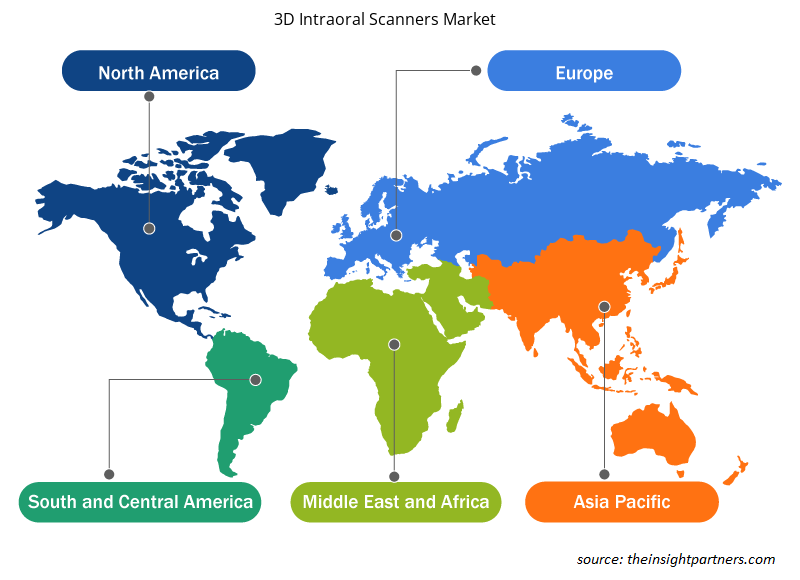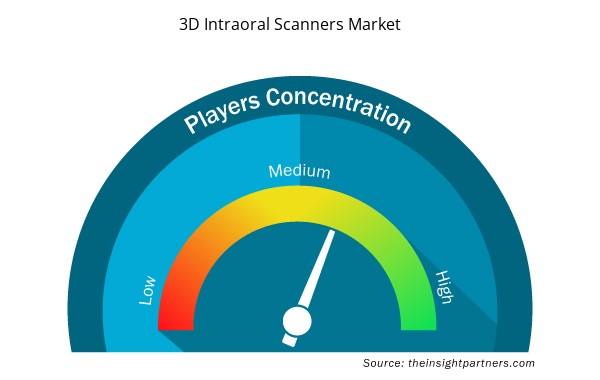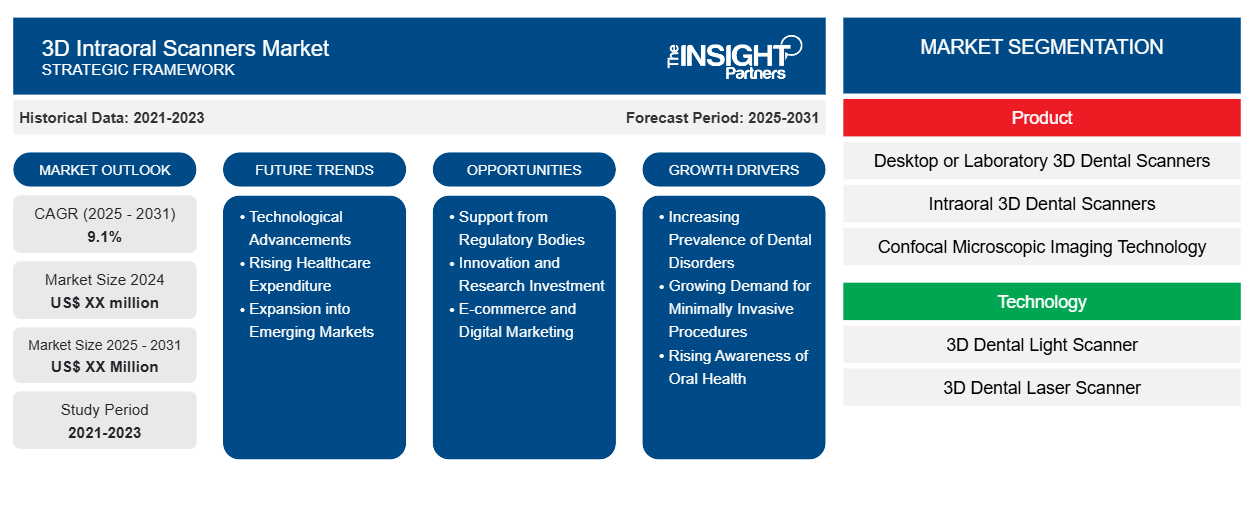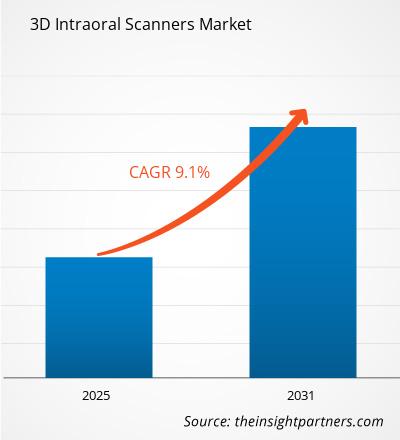Si prevede che il mercato degli scanner intraorali 3D registrerà un CAGR del 9,1% dal 2023 al 2031, con una dimensione di mercato in espansione da XX milioni di dollari nel 2023 a XX milioni di dollari entro il 2031.
Il report è segmentato in base al mercato degli scanner intraorali 3D per prodotto (scanner dentali 3D da tavolo o da laboratorio, scanner dentali 3D intraorali, tecnologia di imaging microscopico confocale, tecnologia a bacchetta ottica, scanner dentali 3D portatili, tomografia computerizzata a fascio conico (CBCT)); tecnologia (scanner dentale 3D con luce, scanner laser dentale 3D); applicazione (ospedale, clinica, altri) e geografia (Nord America, Europa, Asia Pacifico, Medio Oriente e Africa e Sud e Centro America). L'analisi globale è ulteriormente suddivisa a livello regionale e nei principali paesi. Il report offre il valore in USD per l'analisi e i segmenti di cui sopra.
Scopo del rapporto
Il report 3D Intraoral Scanners Market di The Insight Partners mira a descrivere il panorama attuale e la crescita futura, i principali fattori trainanti, le sfide e le opportunità. Ciò fornirà spunti a vari stakeholder aziendali, come:
- Fornitori/produttori di tecnologia: per comprendere le dinamiche di mercato in evoluzione e conoscere le potenziali opportunità di crescita, consentendo loro di prendere decisioni strategiche informate.
- Investitori: condurre un'analisi completa delle tendenze in merito al tasso di crescita del mercato, alle proiezioni finanziarie del mercato e alle opportunità esistenti lungo la catena del valore.
- Enti di regolamentazione: regolamentano le politiche e le attività di controllo sul mercato allo scopo di ridurre al minimo gli abusi, preservare la fiducia degli investitori e sostenere l'integrità e la stabilità del mercato.
Segmentazione del mercato degli scanner intraorali 3D
Prodotto
- Scanner dentali 3D da tavolo o da laboratorio
- Scanner dentali 3D intraorali
- Tecnologia di imaging microscopico confocale
- Tecnologia della bacchetta ottica
- Scanner dentali 3D portatili
- Tomografia computerizzata a fascio conico
Tecnologia
- Scanner dentale 3D con luce
- Scanner laser dentale 3D
Applicazione
- Ospedale
- Clinica
- Altri
Geografia
- America del Nord
- Europa
- Asia-Pacifico
- America del Sud e Centro
- Medio Oriente e Africa
Geografia
- America del Nord
- Europa
- Asia-Pacifico
- America del Sud e Centro
- Medio Oriente e Africa
Personalizza questo report in base alle tue esigenze
Riceverai la personalizzazione gratuita di qualsiasi report, comprese parti di questo report, o analisi a livello nazionale, pacchetto dati Excel, oltre a usufruire di grandi offerte e sconti per start-up e università
- Scopri le principali tendenze di mercato in questo rapporto.Questo campione GRATUITO includerà analisi di dati che spaziano dalle tendenze di mercato alle stime e alle previsioni.
Driver di crescita del mercato degli scanner intraorali 3D
- Prevalenza crescente di disturbi dentali: la necessità di strumenti diagnostici sofisticati è guidata dalla crescente prevalenza di condizioni dentali come la malattia parodontale e le carie. Gli scanner intraorali sono fondamentali nell'odontoiatria contemporanea perché consentono diagnosi precise e pianificazione del trattamento. Tale fattore ha assistito la crescita complessiva del mercato nel recente passato e si prevede che continuerà una tendenza simile durante il periodo di previsione.
- Domanda crescente di procedure minimamente invasive: le preferenze dei pazienti per le procedure odontoiatriche minimamente invasive stanno crescendo. Gli scanner intraorali forniscono impronte digitali accurate senza il disagio che deriva dai materiali per impronte convenzionali, il che incoraggia la loro applicazione in odontoiatria restaurativa e operazioni di ortodonzia. Tale fattore ha assistito la crescita complessiva del mercato nel recente passato e si prevede che continuerà una tendenza simile durante il periodo di previsione.
- Crescente consapevolezza della salute orale: sempre più persone cercano cure dentistiche di routine a seguito della crescente consapevolezza della pulizia e della salute orale. A causa di questa tendenza, i pazienti si aspettano livelli di trattamento maggiori, il che aumenta la domanda di strumenti diagnostici sofisticati come gli scanner intraorali. Tale fattore ha assistito la crescita complessiva del mercato nel recente passato e si prevede che continuerà una tendenza simile durante il periodo di previsione.
Tendenze future del mercato degli scanner intraorali 3D
- Progressi tecnologici: la precisione, l'efficacia e l'usabilità degli scanner intraorali sono tutti aumentati grazie ai continui progressi nella tecnologia di imaging digitale. L'imaging ad alta risoluzione e le velocità di scansione più rapide sono due caratteristiche che migliorano il flusso di lavoro degli studi dentistici e incoraggiano più professionisti a utilizzare questi strumenti. Tale fattore ha assistito la crescita complessiva del mercato nel recente passato e si prevede che continuerà una tendenza simile durante il periodo di previsione.
- Aumento della spesa sanitaria: una maggiore spesa sanitaria a livello globale consente alla maggior parte delle persone di cercare cure dentistiche, che sono anche la sostituzione dei denti. Ciò apre la strada a un aumento della domanda di scanner intraorali 3D dentali, poiché più pazienti iniziano a interessarsi alla propria salute.
- Espansione nei mercati emergenti: il miglioramento delle condizioni economiche, l'aumento dei redditi disponibili e una maggiore consapevolezza dell'importanza della salute orale dovrebbero contribuire a una rapida crescita nei mercati emergenti, in particolare nella regione Asia-Pacifico. Le aree regionali stanno diventando sempre più mete ricercate per il turismo medico associato ai trattamenti odontoiatrici, grazie ai costi di trattamento sostanzialmente inferiori.
Opportunità di mercato degli scanner intraorali 3D
- Supporto da parte degli enti normativi: l'uso di scanner intraorali negli studi dentistici è incoraggiato da norme e linee guida favorevoli stabilite dalle autorità sanitarie. Seguire queste linee guida garantisce sicurezza ed efficacia, il che aumenta la fiducia dei professionisti. Tale fattore ha assistito la crescita complessiva del mercato nel recente passato e si prevede che continuerà una tendenza simile durante il periodo di previsione.
- Investimenti in innovazione e ricerca: gli scanner intraorali sono resi più funzionali dalla loro compatibilità con i sistemi di progettazione e produzione assistita da computer (CAD/CAM), che consentono flussi di lavoro fluidi dalla scansione alla produzione di restauri dentali. Gli esperti dentali che desiderano semplificare le proprie procedure troveranno questa integrazione interessante. Tale fattore ha assistito la crescita complessiva del mercato nel recente passato e si prevede che continuerà una tendenza simile durante il periodo di previsione.
- E-commerce e marketing digitale: gli studi dentistici ora possono acquistare più facilmente scanner intraorali grazie alla crescita dei mercati online per gli acquisti di apparecchiature mediche. Inoltre, le tecniche di marketing digitale aiutano a istruire i potenziali clienti sui vantaggi di questi gadget. Tale fattore ha assistito la crescita complessiva del mercato nel recente passato e si prevede che continuerà una tendenza simile durante il periodo di previsione.
Approfondimenti regionali sul mercato degli scanner intraorali 3D
Le tendenze regionali e i fattori che influenzano il mercato degli scanner intraorali 3D durante il periodo di previsione sono stati ampiamente spiegati dagli analisti di Insight Partners. Questa sezione discute anche i segmenti di mercato degli scanner intraorali 3D e la geografia in Nord America, Europa, Asia Pacifico, Medio Oriente e Africa e America meridionale e centrale.

- Ottieni i dati specifici regionali per il mercato degli scanner intraorali 3D
Ambito del rapporto di mercato sugli scanner intraorali 3D
| Attributo del report | Dettagli |
|---|---|
| Dimensioni del mercato nel 2023 | XX milioni di dollari USA |
| Dimensioni del mercato entro il 2031 | XX milioni di dollari USA |
| CAGR globale (2023-2031) | 9,1% |
| Dati storici | 2021-2022 |
| Periodo di previsione | 2024-2031 |
| Segmenti coperti | Per Prodotto
|
| Regioni e Paesi coperti | America del Nord
|
| Leader di mercato e profili aziendali chiave |
|
Densità dei player del mercato degli scanner intraorali 3D: comprendere il suo impatto sulle dinamiche aziendali
Il mercato degli scanner intraorali 3D sta crescendo rapidamente, spinto dalla crescente domanda degli utenti finali dovuta a fattori quali l'evoluzione delle preferenze dei consumatori, i progressi tecnologici e una maggiore consapevolezza dei vantaggi del prodotto. Con l'aumento della domanda, le aziende stanno ampliando le loro offerte, innovando per soddisfare le esigenze dei consumatori e capitalizzando sulle tendenze emergenti, il che alimenta ulteriormente la crescita del mercato.
La densità degli operatori di mercato si riferisce alla distribuzione di aziende o società che operano in un particolare mercato o settore. Indica quanti concorrenti (operatori di mercato) sono presenti in un dato spazio di mercato in relazione alle sue dimensioni o al valore di mercato totale.
Le principali aziende che operano nel mercato degli scanner intraorali 3D sono:
- Scienza 3M
- 3Forma
- Azienda: AICON 3D Systems GmbH
- Age Solutions srl
- Allinea la tecnologia
Disclaimer : le aziende elencate sopra non sono classificate secondo un ordine particolare.

- Ottieni una panoramica dei principali attori del mercato degli scanner intraorali 3D
Punti chiave di vendita
- Copertura completa: il rapporto copre in modo completo l'analisi di prodotti, servizi, tipologie e utenti finali del mercato degli scanner intraorali 3D, fornendo una panoramica olistica.
- Analisi degli esperti: il rapporto è compilato sulla base della conoscenza approfondita di esperti e analisti del settore.
- Informazioni aggiornate: il rapporto garantisce la pertinenza aziendale grazie alla copertura di informazioni recenti e tendenze nei dati.
- Opzioni di personalizzazione: questo report può essere personalizzato per soddisfare le esigenze specifiche del cliente e adattarsi in modo appropriato alle strategie aziendali.
Il rapporto di ricerca sul mercato degli scanner intraorali 3D può quindi aiutare a guidare il percorso di decodifica e comprensione dello scenario del settore e delle prospettive di crescita. Sebbene possano esserci alcune preoccupazioni valide, i vantaggi complessivi di questo rapporto tendono a superare gli svantaggi.
- Analisi storica (2 anni), anno base, previsione (7 anni) con CAGR
- Analisi PEST e SWOT
- Valore/volume delle dimensioni del mercato - Globale, regionale, nazionale
- Industria e panorama competitivo
- Set di dati Excel



Report Coverage
Revenue forecast, Company Analysis, Industry landscape, Growth factors, and Trends

Segment Covered
This text is related
to segments covered.

Regional Scope
North America, Europe, Asia Pacific, Middle East & Africa, South & Central America

Country Scope
This text is related
to country scope.
Domande frequenti
Support from Regulatory Bodies
Budgetary Constraints
Increasing Prevalence of Dental Disorders
Asia Pacific region is expected to witness the highest growth during the forecast period
Europe region is expected to witness a high growth rate in terms of CAGR after Asia Pacific region during the forecast period
The 3D Intraoral Scanners Market is estimated to witness a CAGR of 9.1% from 2023 to 2031
Trends and growth analysis reports related to Life Sciences : READ MORE..
1. 3M Science
2. 3Shape
3. AICON 3D Systems GmbH
4. Age Solutions s.r.l
5. Align Technology
6. Adstar
7. CareStream
8. Carl Zeiss Optotechnik GmbH
9. Condor
10. Danaher Corporation
11. Densys
12. Dental Wings - Straumann
13. Dipro
14. GC Corporation
15. GT Medical
16. Heraeus Kulzer
17. Hint-ELS
18. Imes-icore
19. Imetric 3D
20. LaserDentium
The Insight Partners performs research in 4 major stages: Data Collection & Secondary Research, Primary Research, Data Analysis and Data Triangulation & Final Review.
- Data Collection and Secondary Research:
As a market research and consulting firm operating from a decade, we have published and advised several client across the globe. First step for any study will start with an assessment of currently available data and insights from existing reports. Further, historical and current market information is collected from Investor Presentations, Annual Reports, SEC Filings, etc., and other information related to company’s performance and market positioning are gathered from Paid Databases (Factiva, Hoovers, and Reuters) and various other publications available in public domain.
Several associations trade associates, technical forums, institutes, societies and organization are accessed to gain technical as well as market related insights through their publications such as research papers, blogs and press releases related to the studies are referred to get cues about the market. Further, white papers, journals, magazines, and other news articles published in last 3 years are scrutinized and analyzed to understand the current market trends.
- Primary Research:
The primarily interview analysis comprise of data obtained from industry participants interview and answers to survey questions gathered by in-house primary team.
For primary research, interviews are conducted with industry experts/CEOs/Marketing Managers/VPs/Subject Matter Experts from both demand and supply side to get a 360-degree view of the market. The primary team conducts several interviews based on the complexity of the markets to understand the various market trends and dynamics which makes research more credible and precise.
A typical research interview fulfils the following functions:
- Provides first-hand information on the market size, market trends, growth trends, competitive landscape, and outlook
- Validates and strengthens in-house secondary research findings
- Develops the analysis team’s expertise and market understanding
Primary research involves email interactions and telephone interviews for each market, category, segment, and sub-segment across geographies. The participants who typically take part in such a process include, but are not limited to:
- Industry participants: VPs, business development managers, market intelligence managers and national sales managers
- Outside experts: Valuation experts, research analysts and key opinion leaders specializing in the electronics and semiconductor industry.
Below is the breakup of our primary respondents by company, designation, and region:

Once we receive the confirmation from primary research sources or primary respondents, we finalize the base year market estimation and forecast the data as per the macroeconomic and microeconomic factors assessed during data collection.
- Data Analysis:
Once data is validated through both secondary as well as primary respondents, we finalize the market estimations by hypothesis formulation and factor analysis at regional and country level.
- Macro-Economic Factor Analysis:
We analyse macroeconomic indicators such the gross domestic product (GDP), increase in the demand for goods and services across industries, technological advancement, regional economic growth, governmental policies, the influence of COVID-19, PEST analysis, and other aspects. This analysis aids in setting benchmarks for various nations/regions and approximating market splits. Additionally, the general trend of the aforementioned components aid in determining the market's development possibilities.
- Country Level Data:
Various factors that are especially aligned to the country are taken into account to determine the market size for a certain area and country, including the presence of vendors, such as headquarters and offices, the country's GDP, demand patterns, and industry growth. To comprehend the market dynamics for the nation, a number of growth variables, inhibitors, application areas, and current market trends are researched. The aforementioned elements aid in determining the country's overall market's growth potential.
- Company Profile:
The “Table of Contents” is formulated by listing and analyzing more than 25 - 30 companies operating in the market ecosystem across geographies. However, we profile only 10 companies as a standard practice in our syndicate reports. These 10 companies comprise leading, emerging, and regional players. Nonetheless, our analysis is not restricted to the 10 listed companies, we also analyze other companies present in the market to develop a holistic view and understand the prevailing trends. The “Company Profiles” section in the report covers key facts, business description, products & services, financial information, SWOT analysis, and key developments. The financial information presented is extracted from the annual reports and official documents of the publicly listed companies. Upon collecting the information for the sections of respective companies, we verify them via various primary sources and then compile the data in respective company profiles. The company level information helps us in deriving the base number as well as in forecasting the market size.
- Developing Base Number:
Aggregation of sales statistics (2020-2022) and macro-economic factor, and other secondary and primary research insights are utilized to arrive at base number and related market shares for 2022. The data gaps are identified in this step and relevant market data is analyzed, collected from paid primary interviews or databases. On finalizing the base year market size, forecasts are developed on the basis of macro-economic, industry and market growth factors and company level analysis.
- Data Triangulation and Final Review:
The market findings and base year market size calculations are validated from supply as well as demand side. Demand side validations are based on macro-economic factor analysis and benchmarks for respective regions and countries. In case of supply side validations, revenues of major companies are estimated (in case not available) based on industry benchmark, approximate number of employees, product portfolio, and primary interviews revenues are gathered. Further revenue from target product/service segment is assessed to avoid overshooting of market statistics. In case of heavy deviations between supply and demand side values, all thes steps are repeated to achieve synchronization.
We follow an iterative model, wherein we share our research findings with Subject Matter Experts (SME’s) and Key Opinion Leaders (KOLs) until consensus view of the market is not formulated – this model negates any drastic deviation in the opinions of experts. Only validated and universally acceptable research findings are quoted in our reports.
We have important check points that we use to validate our research findings – which we call – data triangulation, where we validate the information, we generate from secondary sources with primary interviews and then we re-validate with our internal data bases and Subject matter experts. This comprehensive model enables us to deliver high quality, reliable data in shortest possible time.


 Ottieni un campione gratuito per questo repot
Ottieni un campione gratuito per questo repot